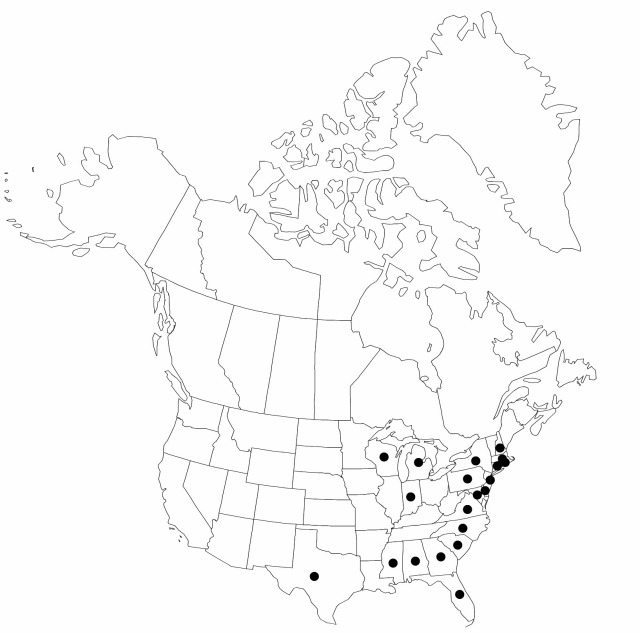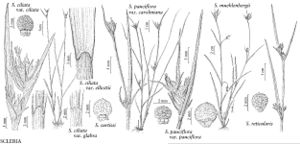Scleria reticularis
Fl. Bor.-Amer. 2: 167. 1803.
Plants; roots purplish, fibrous; rhizomes short (in perennial forms). Culms solitary or in tufts, erect or spreading, slender, (6–)15–50 cm, glabrous or hairy. Leaves: sheaths often purple-tinged at base, sometimes somewhat winged, ribbed, glabrous or densely pubescent; contra-ligules rotund-obtuse, short; blades linear, flat, often ribbed, obtuse, shorter than or equaling culm, 1–3.5 mm wide, glabrous or occasionally margins and veins abaxially scabrous. Inflorescences axillary and terminal, paniculate; panicles compact, 8–25 mm, lateral clusters sessile or on short erect peduncles to 20(–90) mm; bracts subtending inflorescence leaflike, distalmost lateral bract 3/4 as long as to exceeding terminal internode. Spikelets bisexual or unisexual; staminate spikelets 2–3 mm, pistillate spikelets 3–4(–5) mm; staminate scales lanceolate; pistillate scales ovate-lanceolate, apex acuminate. Achenes gray or brownish and/or with dark interangular lines and little pubescence, globose to ovoid, 1.5–2 mm, apex umbonate, surface reticulate to completely smooth, somewhat verrucose in some forms, reticulations pubescent with tufts of yellowish hairs; hypogynium distinctly 3-lobed, lobes ovate-lanceolate, apex obtuse, sometimes emarginate.
Phenology: Fruiting summer–fall.
Habitat: Moist or wet sandy or sandy-peaty soil of pond and lake margins, wet savannas, and moist swales
Elevation: 0–500 m
Distribution

Ala., Conn., Del., Fla., Ga., Ind., Md., Mass., Mich., Miss., N.H., N.J., N.Y., N.C., Pa., R.I., S.C., Tex., Va., Wis.
Discussion
Scleria reticularis is a smaller plant and less widely distributed than S. muehlenbergii. In addition to the difference noted in the key, S. reticularis differs from S. muehlenbergii in having the lobe of the hypogynium obtuse and emarginate at the apex rather than obtuse to acute, the terminal internode of the stem usually 3–8 cm rather than 6–30 cm, and scales of pistillate flowers mostly 3–4 mm rather than 4–5 mm.
Scleria reticularis is a relatively uniform species throughout its restricted range. It does not occur outside of the United States and is infrequent in the southern portion of its range. The key characters used to separate S. reticularis from S. muehlenbergii apply only to temperate collections.
Selected References
None.
